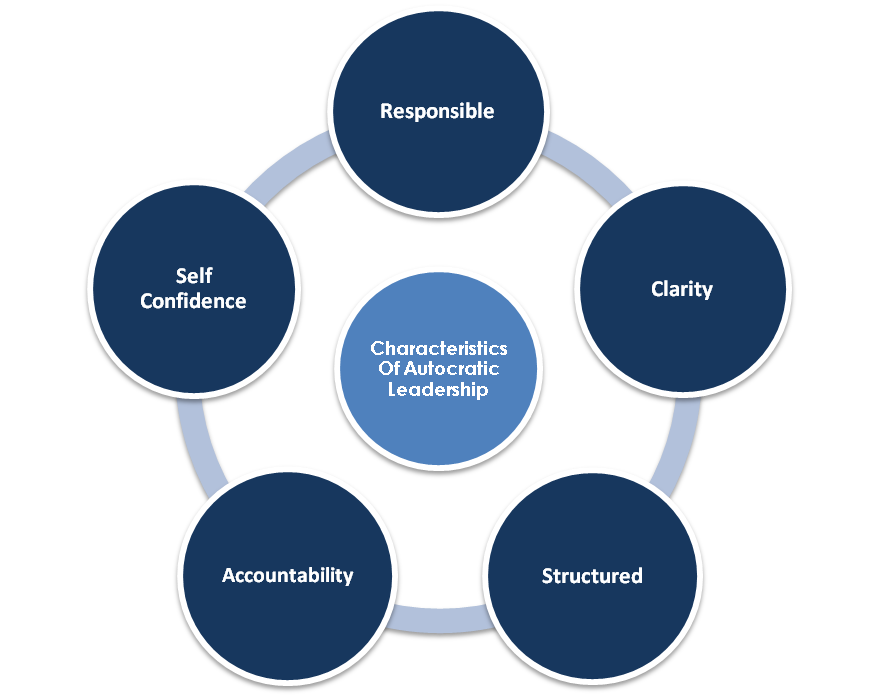What is Autocratic Leadership? Learn its Characteristics, Benefits & Examples
Table of Contents

- jaro education
- 26, February 2024
- 10:56 am
Leaders are inspirations! Leadership is an important step in the achievement of any organisation’s success. As we know, all leaders most probably have a lot in common, such as being passionate and committed. But the style of leadership is different. Each person has their own unique approach and impact on the manager. One such style is autocratic leadership. Now you must be wondering what’s the hype about is. Well, to be honest, autocratic leadership have been praised over the years. This is because autocratic leadership is considered a direct, no-nonsense approach to leadership, making it effective in different professional scenarios. They are mostly considered in situations where ambiguity can be a liability.
So, if you want to know more about the autocratic leadership, this blog is for you. We have outlined what autocratic leadership is, its characteristics, benefits, and examples to show you how it can be beneficial for you. Let’s get started.
What is the Autocratic Leadership Style?
Autocratic, also called authoritarian leadership, is one of the management styles in which leaders are solely responsible for making all executive and operational decisions. It is especially effective in situations where prompt decision actions are required, such as in highly regulated industries where compliance with strict guidelines is important. Autocratic leaders mainly make decisions based on judgements, concepts, and ideas without accepting any advice from their followers. However, it is said that everything has two sides- good and bad. Some people see autocratic leadership as a bossy and dictator-like control in some situations. Thus, it is advised that it should be employed judiciously.
Characteristics of Autocratic Leadership
Unlike democratic and laissez-faire leadership styles, autocratic leadership is often prevalent in trivial matters and, in many ways, represents a more effective form of leadership. Here are three key features that characterise this particular style of leadership:

*ujji.io
-
- Centralised Decision-Making: Conventional autocratic leadership places decision-making power solely in the hands of the leader, with executive decisions made independently. There is little to no opportunity for subordinates to influence these decisions. Immense power is concentrated in the leader, who does not expect creative compliance but rather absolute obedience, as instructions are meant to be followed to the letter.
- Strict Rules, Standards, and Accountability: Autocratic leaders enforce strict rules and high-quality performance expectations to keep everything in control. The team are required to perform and should not be swayed by the managers’ way of doing things. Those who perform below the expected level are likely to face punishment or even dismissal. This category of leadership styles tends to produce managers who carefully monitor the performance of their subordinates to ensure targets are met effectively.
- Limited Scope for Initiative: The situational leadership model gives employees some freedom to take initiative only when they are assigned specific tasks. In contrast, the democratic model allows employees to have more freedom to take initiative in general. A course of action is issued by leaders, while employees only carry out orders and do no independent work. The followers or subordinates are noticeably silent, waiting for orders, but not taking part in the decision-making process.
Examples of Autocratic Leadership
Undoubtedly, there are several popular examples of people who took on the autocratic form of leadership with different implementation contexts and effectiveness. Let’s understand them one by one.
1. Donald Trump
A former President of the United States, Donald Trump, is a well-known businessman who is quite popular for his autocratic approach to leadership. While heading The Trump Organisation, decision-making was a one-man show, as he controlled all critical business processes.
However, when Trump used the same leadership style as the President, the results were highly divisive and hard to see as positive. The rigid, controlling approach that worked well in business didn’t translate effectively to the complex world of national politics, which requires teamwork, negotiation, and understanding.
2. Bill Gates
As a co-founder and former chief executive officer of Microsoft Corporation, Bill Gates initially adopted an authoritarian managerial style. He expected nothing less than the best from his subordinates and made pivotal decisions independently. However, unlike pure autocrats, he recognized the value of participative leadership. He actively sought responses and suggestions from selected subjects and associates, particularly those involved in technical and product development.
Under his leadership, Microsoft expanded and became the most valuable technology company in the world. This demonstrates that autocratic styles can be effectively utilized when combined with strategic manipulation.
3. Napoleon Bonaparte
Napoleon Bonaparte, the military leader and emperor of France, is a great example of autocratic leadership. Called an iron-fisted ruler, he dismissed advice and made all decisions himself, even leading massive armies into battle. Under his command, he built a French army of over 70 million, showcasing his ability to execute large-scale operations effectively. His leadership shows loyalty, decisive action, and strict discipline. However, his inflexibility ultimately contributed to his downfall, as he struggled to adapt to critical situations.
Advantages and Disadvantages of Autocratic Leadership Style
The advantages and disadvantages of the autocratic leadership style are given below in the table:
| Advantages | Description |
|---|---|
| Fast Decision-Making | This leadership style promotes quicker decision-making because there is no one involved in the decision-making except the leader. When a single authority is given power, making use of that power entails prompt action that helps fulfil objectives efficiently. |
| Improves Productivity and Efficiency | Making quick decisions and having a clearly defined role help to increase the productivity of the team. Employees can do their tasks and take action more actively, which ultimately leads to improved performance. |
| Structured and Disciplined Approach | There are guidelines and work procedures that are followed to make sure that both the organisation and the team are systematically making progress without chaos. |
| Clear Communication | In the style of autocratic leaders, there is communication rather than consultation. This promotes clear message communication that lowers inefficiency. |
| Control | Leaders monitor the implementation of activities by an employee to the latter, ensuring that everything is done according to the established goals. |
| Helps in Crisis Management | This style of leadership in the organisation works well when there is a crisis. The leader controls everything, concentrates on solution delivery, and overcomes difficulties without seeking the approval of any hierarchy. |
| Disadvantages | Description |
|---|---|
| Micromanagement | To reduce the incidence of mistakes, leaders may tend to indulge in excessive supervision, which in turn hinders the productivity of the employees and causes work ethics to deteriorate slowly in due course. |
| Lack of Creativity | A group can give better ideas than a single person. Autocratic leadership does not allow for feedback, discussions or even creativity which inhibits innovation and sustainable growth. |
| Dependable System | The employees develop a reliance on the authority of the leader. The moment the leader is absent, they find it difficult to take charge which prevents the growth of the team as well as individual members. |
| Discourages Ideas and Inputs | As a result of the reduced frequency of meetings, new ideas are often neglected. Personal biases may lead leaders to dismiss certain recommendations, which can frustrate team members and discourage them from contributing further. |
| Might Affect Work Culture Negatively | When leaders establish moral standards and codes of conduct, it can serve as a motivating force within the organisation. However, in the presence of ineffective leadership, this approach may lead to employees feeling compelled to leave or experiencing significant psychological distress. |
| Less Room for Employee Growth | Autocratic leadership does not encourage taking feedback or making suggestions resulting in limited decision-making; therefore, the employee’s soft skills are not enhanced, and the personal development of the employee is stunted. |
How to Be Successful With Autocratic Leadership?
This type of leadership can be beneficial in specific contexts. Therefore, if such leadership behaviour is your default, there are techniques that you need to follow and make your way of leading others successful.
- Listen to Team Members
Although it may not always seem appropriate to follow what team members have to say, it is vital for subordinates to feel that their opinions are valued. By fostering this mindset, a listening culture can be created where individuals feel involved and believe their contributions are essential to achieving the group’s goals, even when the leader ultimately makes the final decision.
- Establish Clear Rules
Setting clear parameters is one of the critical leadership styles that define power distance relationships. Team members should be aware of and understand these rules properly. Ensure that joint attention, objectives, and task procedures are outlined from the beginning to avoid any ambiguity regarding requirements.
- Provide the Right Tools and Resources
A leader cannot only give instructions and delegate tasks. It is also obligatory to make sure that the team possesses the knowledge, means, and resources necessary to fulfil the leader’s demands. When there is a requirement for any training to boost skills, make sure that your team members get the right supervision and assistance. In addition, providing the team with power and authority means ensuring that they can do their job adequately.
- Be a Reliable Leader
Leaders who change their behaviours from time to time lose their trust in a team. You can earn the respect of team members as long as you do what you say you will do and uphold the rules you have established. This type of leadership also applies to the behaviour and commitment of the people you lead.
- Recognise Success
The downside of autocratic leadership is that it often focuses only on mistakes or shortcomings. However, encouraging your team should not be limited to pointing out negative aspects. Be intentional that you will always praise and reward success. This is because, when a team feels that their work is appreciated, they will take feedback positively and strive to perform to the best of their abilities.
Now, the question comes: how can you develop this leadership quality? Well, we have the answer. There is a course available that can help you cultivate these leadership skills. Let’ understand this in details.
Corporate and Public Leadership in a VUCA World
The curriculum designed for management professionals in the Corporate and Public Leadership in a VUCA World – IIM Indore enables them to address complex issues as public leaders. With this interactive course, you can gain insights from the eminent faculty and scholars at IIM Indore, who will guide participants in exploring key topics such as the evolving relationships among business, government, and society, negotiation strategies for effective stakeholder management, and risk assessment in light of geopolitical developments. Here’s what you can expect from the course.
- This is an interdisciplinary course on leadership which draws from psychology, political sociology, and public policy – exploring the personal, organisational and global facets in that order.
- The participants also do real-life case studies to develop critical thinking and stakeholder management.
- This programme has experienced instructors and offers a range of flexible learning modes making it suitable for anyone looking to thrive at the interface of business, government and society.
- Get 3-days intensive campus immersion modules
How can Jaro Education Assist?
Jaro Education is an online platform dedicated to higher education and skill development that is designed to help you understand your leadership potential. We facilitate enrollment in the Professional Corporate and Public Leadership in a VUCA World – IIM Indore. Beyond just enrolment assistance, we also serve as the marketing and technology partner for this program.
Also, our professional team is here to extend career support and counselling to students and help them develop essential skills and achieve their professional goals. You can enrol in corporate and public leadership at VUCA World – IIM Indore and get the Jaro Advantage. That includes:
- Lifelong learning experience
- Be a part of discussions and forums for enhanced learning
- Stay up to date with the latest insights from your alma mater
- Access to alumni events & other benefits
- Leverage peer-to-peer learning experience
Conclusion
There are certain situations where autocratic leadership is the best option for management. It encourages fast decision-making and clarifies responsibilities and organisational hierarchy, which are needed in times of crisis.
However, other types of leadership, such as corporate and public leadership, are shaping the business world. So, if you have managerial and leadership qualities, why not pursue corporate and public leadership in a VUCA world from IIM Indore? This is one of the most interactive programmes that highlights the aspect of public leadership from a vast range of social science disciplines. With this programme, you will analyse the emotional, organisational/national (policy level, particularly public policy), and global issues (international perspectives) that influence outcomes in ‘public leadership. So, what are you waiting for? Enrol through Jaro, and get ready to fulfil your dream of becoming a great leader.
Frequently Asked Questions
Autocratic leadership is defined as a type of managerial function in which the whole decision by a leader is made alone as the subordinates are not consulted nor encouraged to give their opinions, rules and effectiveness being the primary emphasis.
Autocratic leadership can be described as one that involves making and imposing organisational policies and rules centre stage and discourages any initiative or independence among employees. The leader rules supreme and controls everything and any insubordination from members of the group is unacceptable.
Some advantages would be timely decisions, enhanced efficiency, unambiguous understanding, better management of crises, and orderly conduct or arrangements of activities.
This leadership style does have its challenges. For instance, it may lead to control freakism, damage to innovation, subservience of the employees to the head, stagnation of self-development and dislike of the organisational environment.








